Part 3. Cowichan to Courtney
Part three includes 12 bowls from locations between Cowichan and Courtney on Vancouver Island, with a few close Gulf Islands included. This is not a complete listing, as there are a number of seated human stone bowls or fragments from private collections that are not included here. Some individuals with private collections, for various reasons, do not want their names made public. I have only included previous owner names here. Many of the images I have copied over the last 50 years from various sources for different purposes. The current location of some and the names of photographers is not known.
Porlier Pass Bowl
This bowl (Figure 1 & 2), is now in a private collection. It has been given the Borden unit number DgRv-Y. It is from the west end of Porlier Pass on Galiano Island, from “Indian Reserve #9”. This could be from one of eight shellmidden sites on the Reserve: DgRv-9, 10, 11, 12, 15, 16, 17, or DgRv-18. Given the size of sites and the nature of site disturbance when this bowl was found around 1947, it is likely from DgRv-9, 10 or 12. RBCM photographs PN7872, PN7575, PN7576, PN 7579, taken at the same time by R. H. Nicholls. Owned by Mrs. E. Gear of Ganges, Saltspring Island. Eight inches high.
The bowl is shown in Duff (1956:136, Plate 9), as Seated human figure bowl No. 31. Described by Duff (1956:34):
“Provenience. – Found a few inches below the surface on the small Indian reserve (I.R. No.9) on Galiano Island at the west end of Porlier Pass about 1947, this figure is now in the Washington State Museum (Accession L-4094). [*The latter is not true. The bowl is in a private collection. The No. L- 4084 is that of a B/W photograph in the Washington State Museum].
Duff (1956:34): “Description. – (From Photographs). The figure is made of coarse sandstone and is about 8 inches high. It depicts a seated human figure holding a bowl. It has been worked by pecking only, and there is little detail.
The head is almost as large as the rest of the figure. It looks slightly upward. The face is framed by a head-dress or hair-do which curves down the sides to below ear level. This is cleft in the middle of the forehead (the hair parting?), and is surmounted by a pair of prominent ear-like mounds side by side on the top of the head. The facial features are as typical as they could be made by pecking on such a coarse stone – large round eyes within lenticular lids, broad nose, and wide full-lipped mouth with lips closed.
The bowl is shallowly excavated in the lap and chest of the figure. Small arms in relief extend part was along the sides of the bowl, and legs are also vaguely shown”.
The photographs in figures 1 and 2, where taken in the Centennial Law Corporation Offices, in 100 MileH, B.C. They were inquiring on behalf of a client. The bowl belonged to their client’s husband’s mother. “Apparently it has been on loan to the Royal B.C. Museum before. Our client was not (sure) when that was”. Stephanie Kappel, Legal Assistant, letter to Gary Mitchell, Provincial Archivist. Nov 29, 2012.
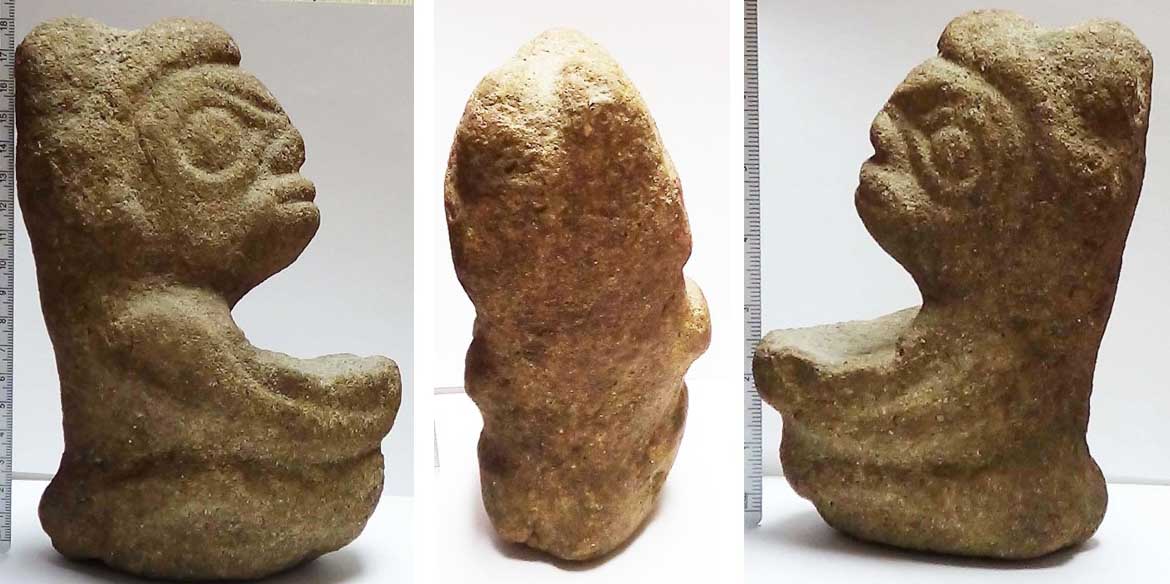

Kuper Island Bowl
This bowl (Figure3), is in the Royal B.C. Museum (old number 1838). Borden Unit No. DfRv-Y. 16cm x 7cm x 13cm deep.
Donated in 1976 by antiquities dealer Howard B. Roloff of Sidney (Accession 2044), who purchased it from the late Edith Cross of Towner Park in Saanich.
The late Beth Hill, of Salt Spring Island, provided me with the information that: “Mrs. Cross bought it from Denis Charlie of Kuper Island, who told her it was found at the southern tip of the Island [in the 1950s]. They were clam digging on the spit at night and had built a large fire on the beach when they found the figure on the beach. There is some trace of red ochre in the bowl, but Mrs. C. said Denis Charles said they had used it (after it was found) in their winter ceremonies and had put the ochre in it”. [Edward “Denis” Charlie (c.1863 – September 22, 1962), is from the Penelakut Band],
Description
This seated human figurine bowl is squatting behind a lower figure that has a grasshopper like appearance from the side, with front legs extending from its back area to the ground. The bend legs of the human are also the back legs of the grasshopper-like creature. The arms of the human figure extend out to the back of the head of the underneath creature, with five distinct fingers showing. The arms form the rim of the bowl between them. It has incised round eyes in an oval eye cut-out, a human like nose and mouth. On top of the head could be either hair or a head-dressing with a top knot at the back-top of the head, Distinct ribs show on the sides of the figure. The bowl is heavily weathered on the left side, showing less detail (Figure 3).

Cowichan Bowl
This bowl (Figure4), is in the British Museum, catalogue AM1896.0125.1. (Figure 4). Archaeological Borden Unit DeRw.
Harlan I. Smith (1907:421, in his Archaeology of Georgia and Puget Sound, shows this bowl as his drawing, figure 183b. Caption: “Made of steatite, from Cowichan Bay (British Museum, Cat. No. 96-1-25-1)”. There is also a drawing of it in Smith (1923:51) as his Plate XV, No. 1.”. Smith’s notes (CMH M82-82) indicate: “Figure was washed up in Cowichan Bay, Vancouver Island, during a high tide in the early part of 1895”.
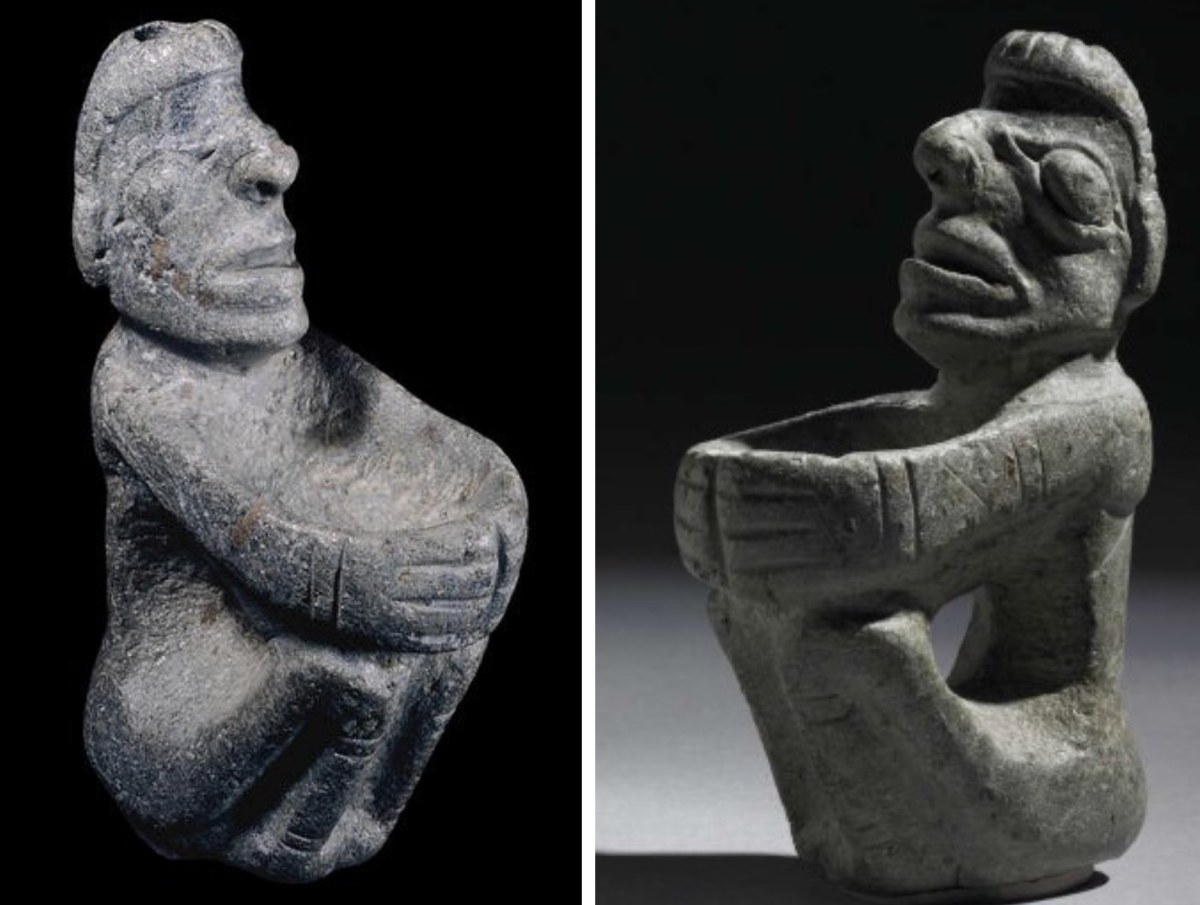
Wilson Duff description
Wilson Duff (1956:34) shows this as his number 32. He describes it as follows “from published illustrations”:
“Made of soapstone, this figure is about 8 ½ inches high. It shows a seated human figure holding a shallow bowl at chest level. The carving cuts between the bowl and the trunk of the figure. The head looks slightly upward. A hair-do in the shape of a segmented ridge extends across the forehead and down the sides to the neck. It is perforated at ear level by drill holes. The large eyes have oval pupils, outlined by incised lids which form elongated corners. The nose is unusually prominent, but is typical in having flaring alae and a perforated septum. The mouth is thick-lipped and partly opened; the chin protruded strongly. On top of the head behind the cornet-like hair-do is a low rounded projection. Otherwise, the head seems to be smooth.
Below the neck the arms extend straight and horizonal completely around the rim of the bowl. A pair of incised lines encircles the wrist, and deep incisions define four large fingers on the hand. Shoulder-blades seem to be indicated. The trunk is thin and carved completely in the round (there is air space between the trunk and the bowl). The knees are just below the hands, and the legs are flexed tightly. Below the knees and at angles, pairs of incised lines encircle the lower leg, perhaps indicating ornaments. No feet are shown”.
I would agree with Duff that the pairs of lines are likely ornaments – bracelets or anklets tied to clothing. I would add that the “hair-do” he refers to may be a ceremonial head piece or a representation of a rattlesnake.
Degnan Bay Bowl (The Grey Bowl)
This bowl (Figures 5-7), is in a private collection. Figure 5, shows the original on the left and one of two casts in the RBCM on the right.
This bowl is from a known archaeological site, DgRv-3, in Degnan Bay, Gabriola Island. It was called the Grey Bowl in RBCM records (and as used in Hanna #57, figure 67, p143), but I prefer, where possible, to use location names rather than finder or owner names. A copies were cast at the RBCM in June of 1973.

Beth Hill provided the information that the figure, then owned by Mr. Gray, was “found in the Garden by son Bob when digging. Head broken off. Head found later by Mr. Gray near gate to beach. He pulled up a weed and the head came out with the root”.
Description
This figure appears to be sitting on its buttocks with its vaguely defined feet joining out in front. It is unusual in having the right arm held to the chest and the left arm back and extending down the back of its side to the legs. Hands are distinct with fingers showing. Four prominent ribs are shown extending from the chest around to the sides. On the head is what appears to be a headpiece that extends back of the ear region and curving down to the open mouth.
The shallow bowl is behind the head and between the shoulders. A ridge extends from the shoulders to form the outer rim of the bowl. There is a prominent nose and round raised eyes with a raised ring close around them and with an arching ridge that extends out around the eyes connecting with the nose. There are no details on the back. The head of the figure has been broken off and re-attached since it was found. It is 21 cm high, 10cm wide and 12.5 cm front to back.
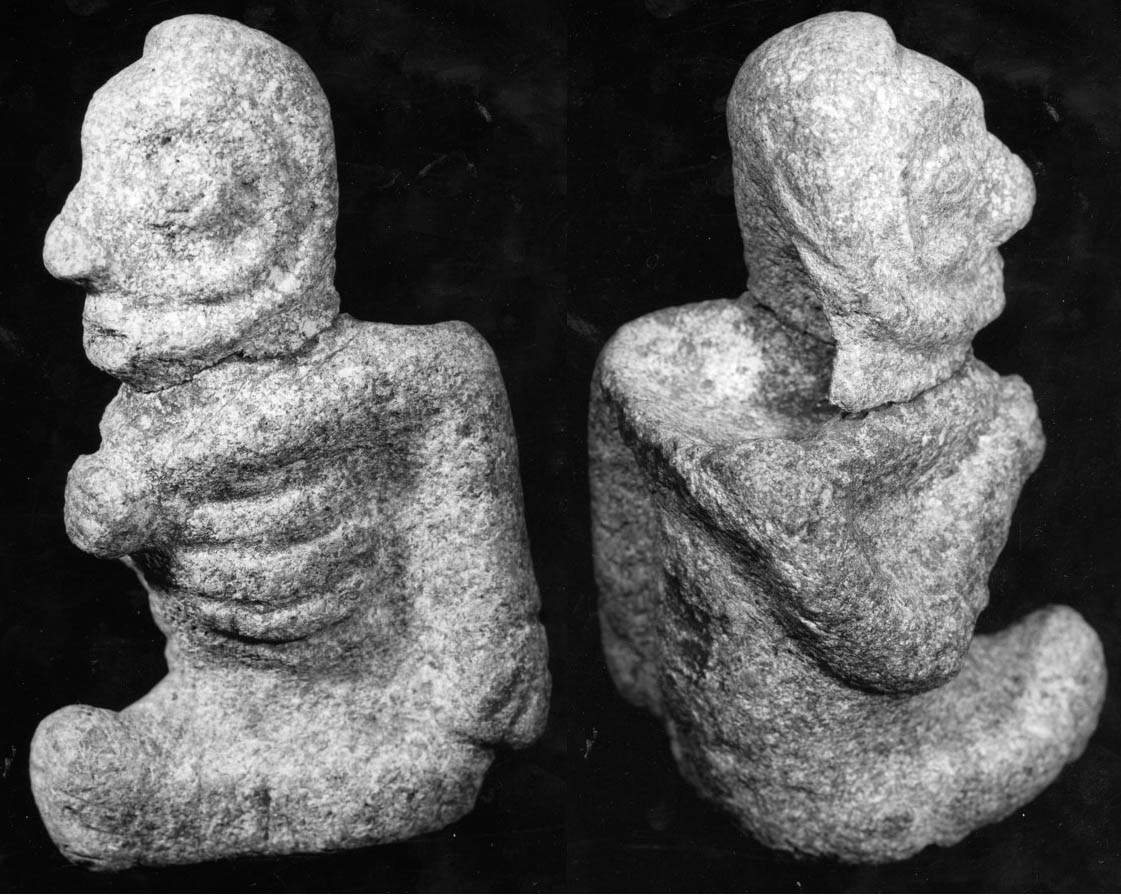

Departure Bay bowl # 1
This small figure (and one cast of it) is In Royal B.C. Museum (old numbers 10959; 1961-145). It is from Borden unit DhRx-Y:6.
This bowl (Figure 8), was originally owned by D. Stevenson and purchased by William Newcombe before coming into the RBCM with the Newcombe collection in 1960,
This bowl is in Duff (1975:64) as his No. 36 and described by Duff (1956:33) as his figure No. 27: “This small bowl, in the private collection of W. A. Newcombe, was found at Departure Bay Near Nanaimo. Description. – This is a short squat figure about 3 ½ inches high, , carved of fine soapstone. It portrays a seated human figure with arms and legs extending around a bowl.
The head is typical in proportions and posture, but the face is smooth and featureless, except for a vaguely defined mouth. In the top of the head are two drilled depressions. The figure sits upright, but is wide and flat bottomed. The bowl is fairly deep. Arms begin with shoulder-blades that extend almost across the back, and rim the bowl. Legs, slightly flexed, have feet which meet in front, and end in hips which extend across the back”.
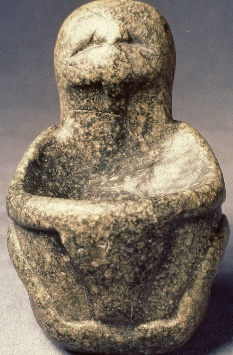
Departure Bay Bowl # 2
This bowl (Figure 9), is in the RBCM (old numbers 3151; 1921-1). It is given the Borden unit DhRx-Y:72. It is one of four found at Departure Bay north of Nanaimo, on Vancouver Island.
Harlin I. Smith records this in has unpublished notes: “Seated figure form with bowl in lap sculptured in grey lava (pumice). From Butler Farm, Departure Bay, B.C. Found about 1890. Cat. No. 3151 in the Provincial Museum, Victoria, B.C. The eyes are represented by two concentric elliptical grooves; the mouth is indicated by one oval groove; the ribs by incised lines; and the sternum by a truncated V with medial incised line. The arms and legs are in relief”.
This bowl is damaged, with parts of the face, sides and front broken off. There is a burnt area with red staining inside the bowl area. The red is likely from burning but it should be tested in the future to see if it is from red ochre or hematite.
Wilson Duff Description:
Duff (1956:33): “The material is a grey pumice, course and vesicular, and soft enough to be cut with other stone tools. The figure is 10 ½ inches high and 6 ½ inches wide. Crudely carved it depicts a seated human figure with bowl. The head is large and bulbous, the top and back plain and fairly smooth. The eyes and mouth are marked on the flat face by incising, the eyes very large and lenticular, the mouth a straight groove across the face. There is a very short thick neck.
The back of the figure is plain. Arms in relief start at the shoulders and extend part way down the brim of the bowl. The upper legs are similarly shown. It is difficult to say whether the front of the bowl has been broken off or whether the bowl is complete as it now stands; it looks as though it may have been broken and the break subsequently smoothed over. The bowl would not now hold liquid.
On the front of the chest three incised vertical lines depict the sternum (of backbone), and curved lines depict ribs. The bottom of the bowl is blackened and some traces of red pigment are visible. The figure does not stand on its base, and totters precariously when lying on its back. Other information. – According to geologists, of the department of mines, pumice does not occur on Vancouver Island, and is highly unlikely to have been transported there by glaciers in the form of boulders. However, it is found on the mainland. It is found as boulders on the beach at Point Grey near Vancouver, and is common in the upper Lillooet River area and other areas.”
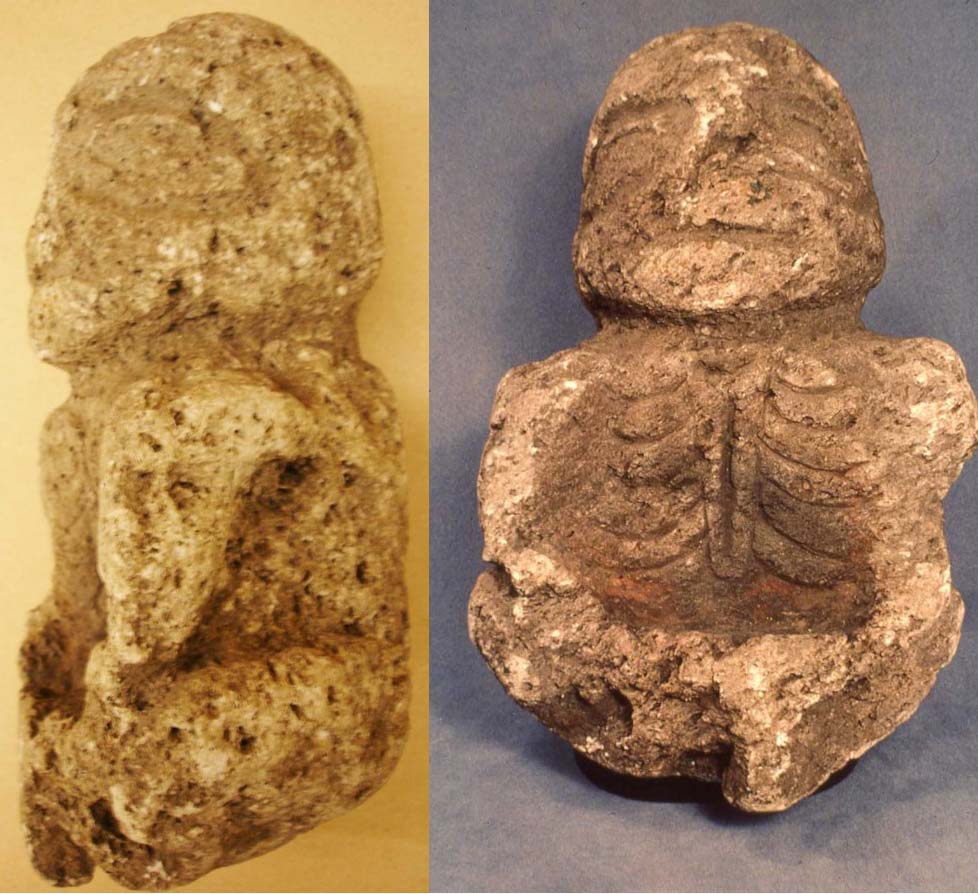
Departure Bay Bowl #3
This bowl (figure 10 & 11), is in the Royal B.C. Museum (old numbers 620; 1890-10), Borden number DhRx-Y:3.
There are drawings in Smith (1907:423, Plate 185b), Archaeology of the Gulf of Georgia and Puget Sound, and in Smith (1923:51, Pl. XV, fig. 2), An Album of Prehistoric Canadian Art. Smith’s caption notes: “Carved dish made of sandstone. From shell-heap Departure Bay, near Nanaimo, Vancouver Island, B.C. Cat. No. 620 in Provincial Museum. Victoria B.C. After Figure 185b, Smith, Gulf of Georgia, 1907. Cast, Cat. No. XII-B-630, in Victoria Memorial Museum, Ottawa. Canada” [now Canadian Museum of History M82-82]. Smith’s 1929, Prehistoric Cat. No. XIII-B-620, Geological Survey of Canada, indicates it was in the possession of “Mrs Christie” in 1890. The figure is 18cm high, 12cm wide and 14cm back to front (Figures 10 & 11).
The drawings in Smith, produced by W. J. Wintemburg and O.E, Prud’homme of the (then) Victoria Memorial Museum, show what is interpreted as a large ear spool on the figures left side (Figure 11).
Duff (1956:33) describes this as his artifact No. 29: “Provenience. – Found at the shell-midden at Departure Bay in 1890, this figure is now In the Provincial Museum, No. 620. Description. – Crudely made of soft sandstone, the figure measures 7 1/4 inches high, 5 ½ inches back to front, and 4 ¾ inches wide. It shows a seated human figure holding a bowl. The roughly formed head looks upward, chin protruding. The features are shallowly formed by pecking but difficult to see. The eyes are shallow circular hollows, the nose a low ridge between them. The mouth is outlined by pecking, with a horizonal incised line between the lips. The rest of the head is plain.
A pronounced rounded ridge extending down the front of the neck probably depicts the trachea. The arms and legs are difficult to see on the eroded surface, but incised fingers meet at the front. The bowl is shallow, but would hold a small amount of liquid when the figure stands upright on its fairly flat face”.
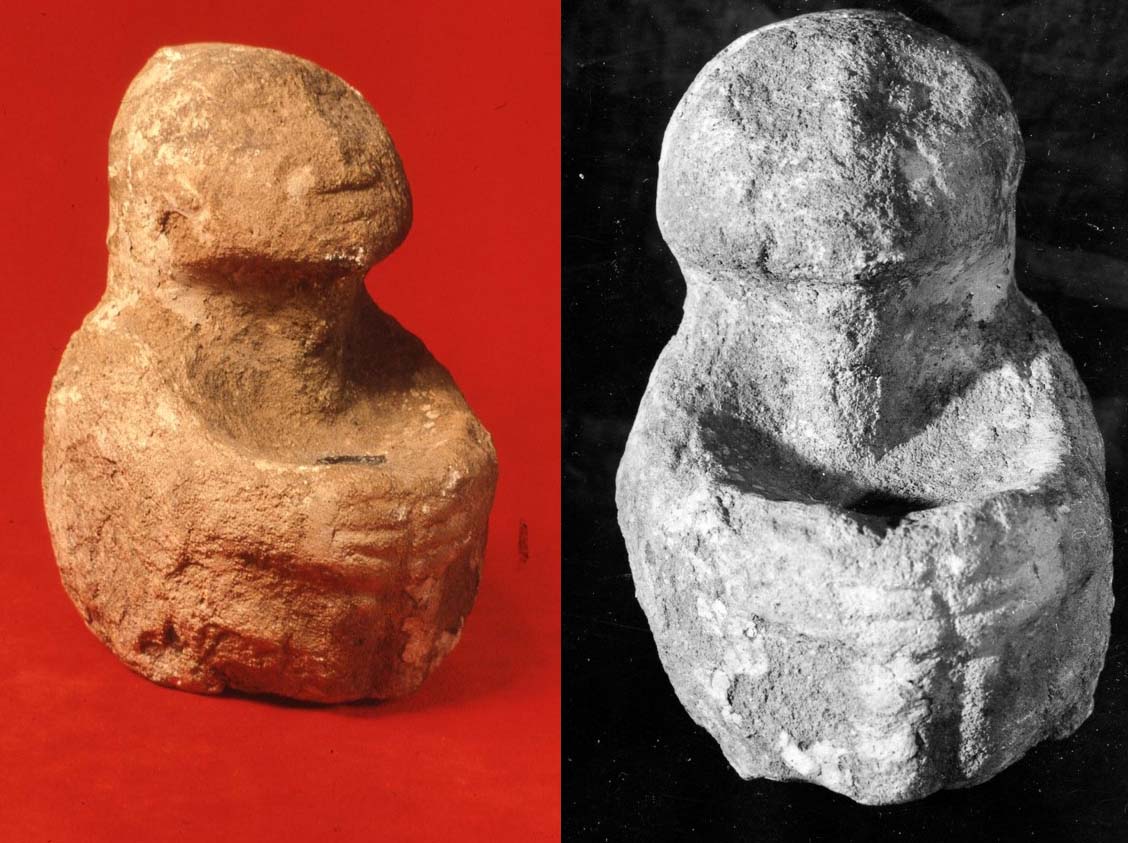

Departure Bay # 4.
This bowl (Figure 12), is from Departure Bay, north of Nanaimo, on Vancouver Island. It is now in the Canadian Museum of History, XII-B-No.1799.
Duff (1956:33), shows this as his number 30 in plate 9A, and describes: “this figure was presented to the National Museum of Canada (No. 1799) by Dr. W. A. Clements in 1939. Description. – Material is a fairly hard light-grey sandstone. Dimensions are: Height, 10 ¼ inches, front to back 8 inches; width 5 inches. The figure is unfinished, but represents a seated human figure holding a bowl. The flat base bowl-like depression , and head have been shaped out, but the only details that have been added are the features of the left side of the face. All the shaping has been done by pecking. The head is narrow, almost ‘hatchet-faced’, and pointed at the top. The round eye, fat cheek, bulbous nose and large rounded mouth have been partially shaped by pecking. The right side of the face and the rest of the figure have not been shaped.
The figure is interesting in that it is the only one known which is definitely unfinished. The fact that it was apparently being made at Departure Bay is of some importance.”

The Gabriola Island Bowl
This Bowl (Figure 13 & 14), is in a private collection. It was found on Gabriola Island. Based on photographs, it appears to be made of sandstone. It is lacking detail, but appears to be a sitting human with arms extending out from the shoulders and joining at the front where they form the rim of the bowl between them. The vague lines and raised area between on the front of the bowl are similar to large joined fingers seen in other bowls in private collections – not shown here. Raised round eyes are set in circular depressed areas. There is a distinct raised triangular nose and raised lips around the mouth. There are no features on the top of the head, which forms a peak. This bowl was recorded by the late Beth Hill. Details might be recorded in her notes. The photograph in figure 13, was likely taken by Beth or Ray Hill, but it is not certain about the others in figure 14, that I computer enhanced as they were under exposed.

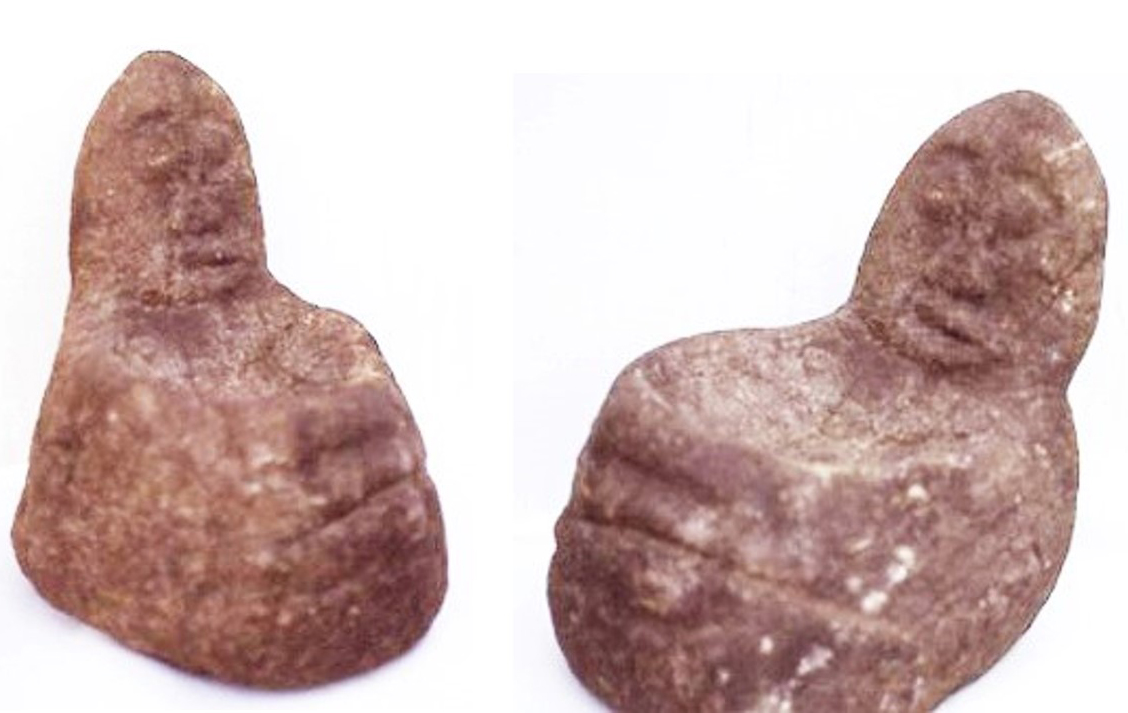
The Qualicum Bowl
This bowl (Figures 15 & 16), is in a private collection. It was found inland from Qualicum Beach about a third of a mile from the bridge that crosses the Little Qualicum River and halfway between the Little Qualicum River and the ocean beach. There is no archaeological site recorded in the immediate area which suggests that the stone bowl figure may have been an isolated find. The area had been heavily logged in the past.
The bowl was found by the late Herb Harris near the back of his property when he was clearing underbrush with a small bladed cat. The Royal B.C. Museum was phoned to report the find and the family was considering donating it to the Royal B.C. Museum, which resulted in a visit by technician Nancy Romain on July 12, 1988. The family changed their minds and the bowl was later inherited by the Harris’s daughter. Romain took slide photographs during her visit which I have cropped and modified for figures 15 & 16.
A controversy arose surrounding this bowl and its commercialization. See the Times Colonist article of June 26, 2013 by Pedro Arrais entitle: CBC comes digging for treasure in Victoria; and the Times Colonist article of July 5, 2013, by Katherine Dedyna, entitled: CBC Unearths Controversy as Island First Nation artifact considered for TV.
The Museum gave the Borden unit number DiSc-Y to the bowl. I provided information and had discussions with the new owners of the Qualicum bowl on two occasions. After the 2013 events referred to in the above articles, the owner decided not to sell the bowl. The images are ones I reconfigured from images taken by Nancy Romain.
Description
This bowl is a squatting human figure with bend knees. The upper arms extend down and then up at the elbow to the top of the chest or in a reaching-up stance. The bent legs hold to half of the bowl which extends out further. Raised ribs appear on the back of the figure behind the arms, Straight lines on arm below the hand and lines on the legs near the ankle and below the knee may represent ornament attachments or part of fitted clothing or a costume. The face of the main figure appears to me as a mask with both human and animal features. It has a hole pierced through either a mouth or a beak-like structure.
There is a face on the lower front of the bowl which could be human or representing another animal, It has half circle eyes with large raised rims encircling below them and extending off to the sides and a mouth incised as a long line. The position of the main human figure suggests that the person is sitting against an object with a carved face.
On the back extending from the tail bone area to the top of the head is a large snake with elongated oval eyes. There is a round configuration at the middle of the top of the snake’s head which appears to have been broken off.
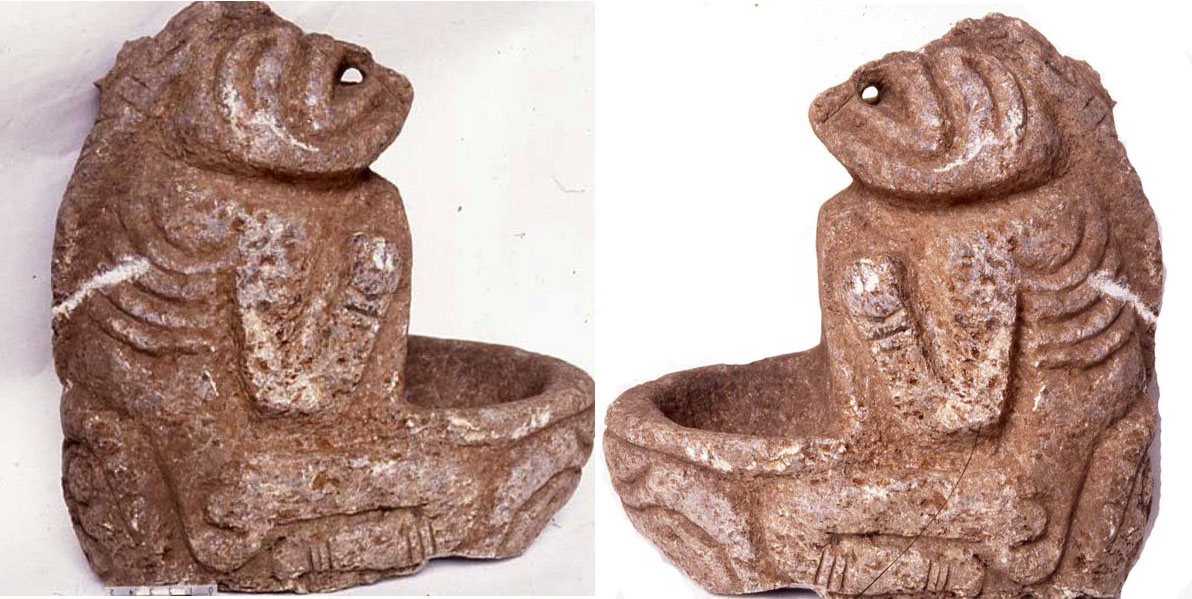

The Royston Bowl
This bowl (Figures 17-19), is the Royal B.C. Museum. Borden unit DjSf-Y:9 (old Museum catalogue numbers 6157 and 1945-26).
Donated by “Miss Mary Campell” in 1945. Found near Royston, south of Courtney “1.2 feet down below a large cedar stump”. This is the same person who donated the Courteney bowl. 13cm high by 5.5cm wide and 6cm back to front. This is shown as Duff(1956:38) No. 43. Mould of this in RBCM.
Wilson Duff Description:
“This small figure is sculptured by pecking, polishing, and incising from fine grey-green soapstone. …It shows a human figure, seated with arms and legs along the sides of a bowl.
The head looks slightly upward, with prominent brow and prominent chin. Lenticular eyes stand in relief. The nose and mouth are well modelled, but do not bear incised or drilled details as some of the figures do. A broken top-knot is perforated laterally by 1/8 – inch diameter drilled holes, and similar perforations are found at each side of the head where slight projections indicate ears.
The neck is a separate section , long and columnar, ending abruptly in shoulders. The back of the figure, from head to hips, is dead flat and smoothed. The arms start at the squares, where the shoulder blades are depicted, and extend in relief down and around the rim of the bowl, almost to the front, ending in lightly incised fingers. Tapering, tightly flexed legs extend along the sides of the bowl; no feet are shown. A vertical ridge down the front of the bowl reveals that the figure was made from a piece of stone that was sawn from both sides, broken off, then the rough ridge between the saw cuts polished, as in the manufacture of nephrite celts.
The bowl is fairly deep, round, and smooth. The base of the figure, like the back, is flat and smoothed. In the middle of the back is a smoothed circular concavity, one-half inch in diameter.”
Duff did not note that the back of the figure has a shallow round hole that may have been the result of earlier unfinished attempts at design features. The distinct holes through the ears were likely used to attach ear ornaments to the figure.
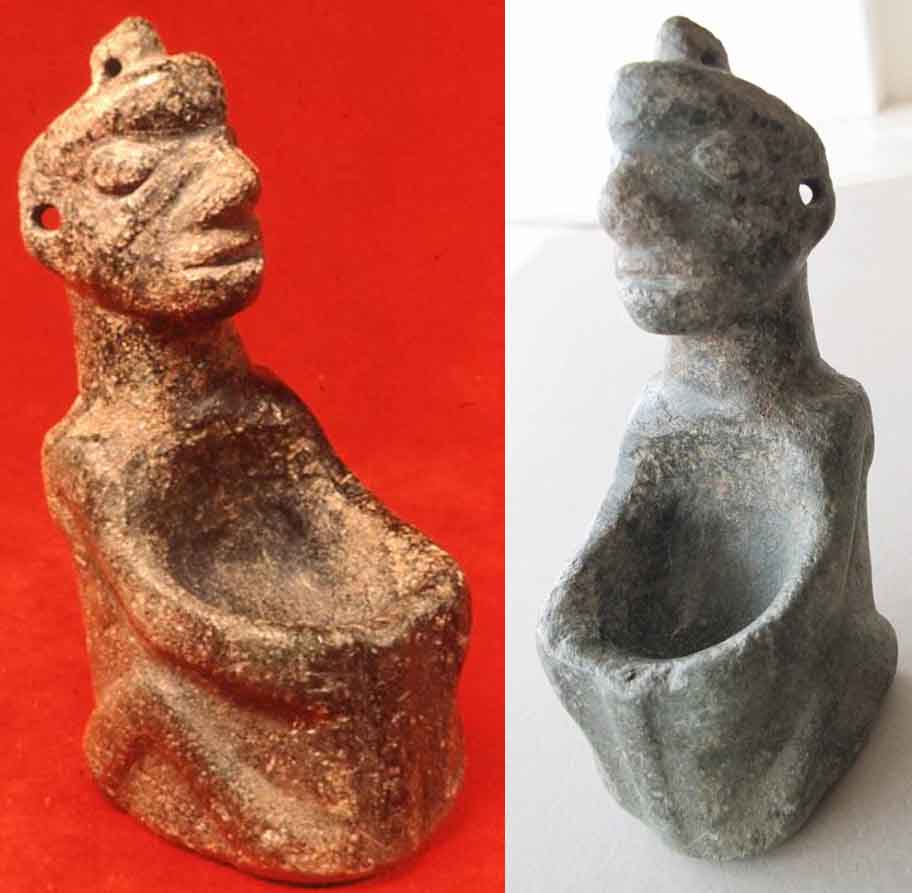

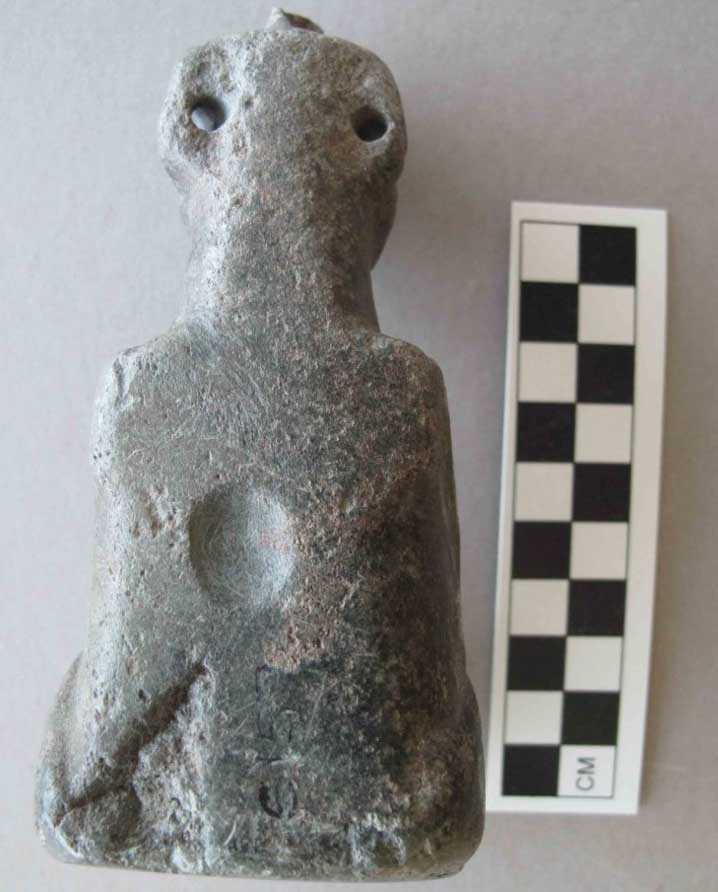
The Courtney Bowl
This bowl (Figure 20 & 21), is in the Royal B.C. (Old accession numbers 6156 and 1945-26). Borden Unit artifact No. DkSf-Y:47. It was found one mile south of Courtenay on Comox Harbour by Donald Campbell (1826-May 16, 1908) of Courtenay and donated to the Provincial Museum by his daughter Mary Campbell (1868-April 31, 1948) of Courtenay in 1945. Charles Newcombe photographed the bowl in December 1913 (negative glass plate, Ec/510; printed later as (PN11236). When Harlan I. Smith, from the (then) National Museum, visited Vancouver Island, he photographed the bowl (figure 20) on August 27, 1928, at Donald Campbell’s Courtney home. Smith noted: “Two seated figure bowls found on west side of the mouth of Courtney River”.
Wilson Duff (1956:139) shows this bowl (his #42) on Plate 12B. There is no report of the donation of this bowl, and the Royston bowl, which came with it, in the usual accessions in the annual report for the Provincial Museum.

Wilson Duff Description
“Provenience. – The bowl and No. 43 [the Royston bowl] donated to the Provincial Museum in 1945 by Mrs. [Miss] Mary Campbell of Courtenay. It was found during the construction of a logging-railway, about a mile south of Courtenay near the shore of Comox Harbour, and at a depth of about three feet. It is now No. 6156 in the museum collection. Description. – Pecked and ground of greenish-grey soapstone. This figure is less upright than most. It measures 7 ½ inches high, 10 inches from to back, and 6 inches wide. The flat oval base is unusually large. There is a large bowl-shaped depression, with a human head raised in the usual form above one end and a large grotesque bird-like face on the other. Arms, legs, and other details are lacking.
The human head is typical, sculptured by pecked and grinding, with details added with incising. The eyes are large and round, defined by incised lines which curve to form short eye corners. The nose if slat and broad, with the alae and nostrils defined by incising. The mouth is wide, closed, but curved slightly in a grin. The cheeks, chin, and brow are smoothly moulded in relief. Ears are depicted at either side by flat projections. These are scored across with an incised cut, which may symbolize pierced ears. Across the head above the brow is a head-dress or hair-do, marked with deep vertical incisions. Above this and further back is a large topknot, constricted at the base and perforated by conically drilled holes from front to back which meet. The whole head is flat and broad, and looks upward.
The neck is less a separate unit than in most of the figures, the head merging into the main body of the bowl. The back of the figure is plain and smooth except for three curved incised ribs on the right side. No shoulder-blades, arms or leg are shown, although the raised ridge that frames the face on the front of the bowl is marked at the bowl’s rim with incised ‘fingers’. The large face on the front of the bowl is very strange. It is framed by a marked ridge which begins as a low brow and sweeps back and down the sides as raised ridges (which are marked as arms). The eyes are large and round, with incised corners, as on the human face. But the noes and beak is puzzling. It is very prominent and curves back to the mouth. Alae and nostrils are clearly shown. The mouth extends from under the nose as an incised groove. The cheeks are prominently and smoothly moulded. Despite the strange peak-like nose, this face is probable meant to be human.
The base of the bowl is broad and flat, so that it sits steadily with the rim of the bowl level. In this position it would hold almost a cup of fluid.”
